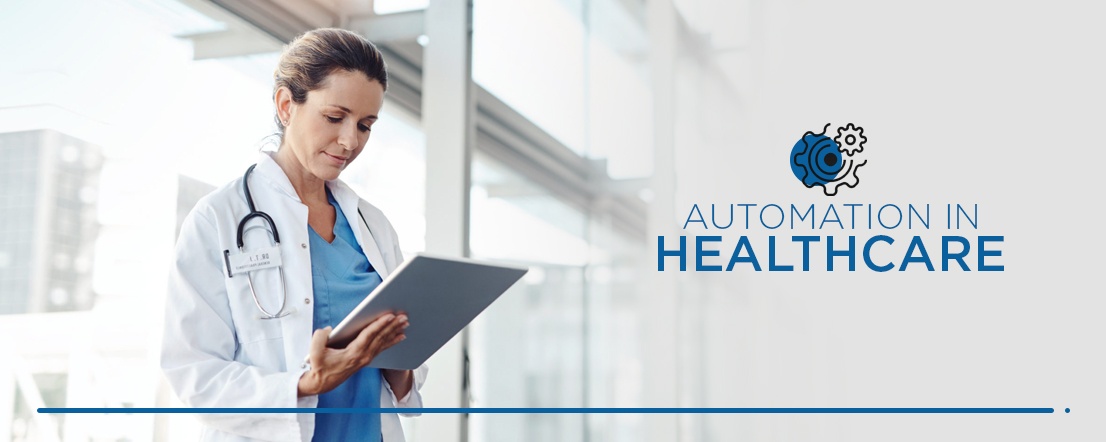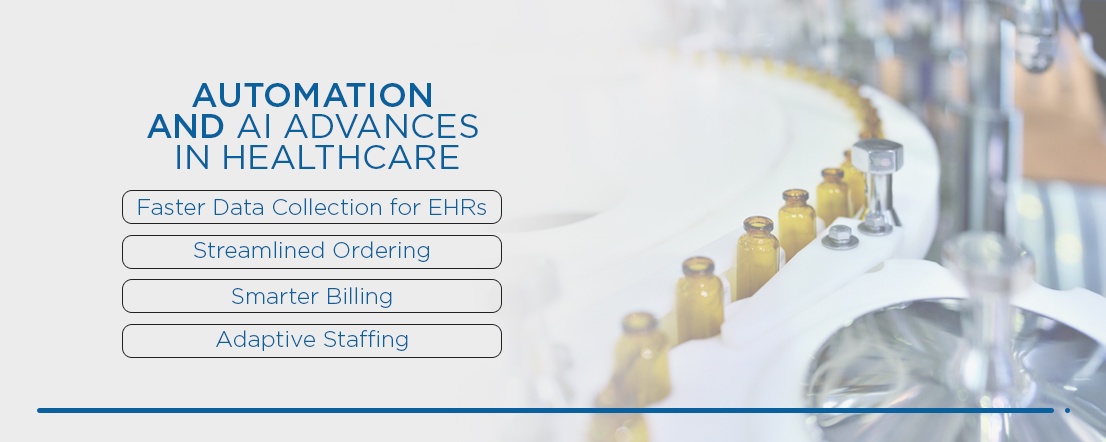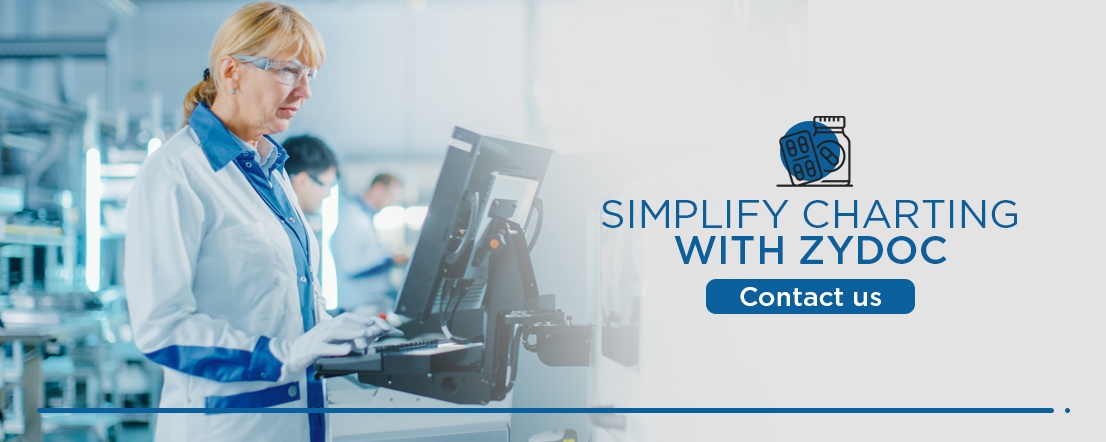Automation in Healthcare
Aug 04, 2020 | Jonathan Maisel
Artificial intelligence (AI) has many dazzling applications in healthcare, such as allowing robots to assist with surgery. However, AI can also help automate crucial functions in the day-to-day administration of healthcare. Using AI to create automated healthcare solutions results in a better experience for patients, better quality care and greater capacity for quality care. In this guide, we’ll explore some of the ways automation drives these better outcomes and discuss real-world examples of automation in action.
How Automation Impacts the Healthcare Industry
The healthcare industry is typically slow to adopt new technologies, but the adoption of AI solutions is rapidly accelerating as providers and IT leaders are prioritizing the improvement of clinical outcomes and operations in large health systems.
So, what is automation in healthcare? AI and machine learning teach computers to extract valuable information from unstructured data through pattern recognition. In the coming years, AI will become integrated into nearly every element of healthcare, from electronic health records (EHRs) to the revenue cycle and administrative operations. Perhaps the most important impact of AI will be in assisting clinical decision-making by providing physicians with thorough analyses of patients’ health histories. AI is already helping to streamline workflows and reduce costs wherever it is integrated.

Automation and AI Advances in Healthcare
How are AI developments driving automation? Here are four of the improvements AI can deliver for healthcare entities:
1. Faster Data Collection for EHRs
EHR technology is advancing at a rapid pace, with vendors working to create platforms that can create and extract critical health information as quickly as possible. In emergency situations, this ability could result in the ability to make better decisions faster. One way to do this is to use a medical transcription service like ZyDoc that uses natural language processing (NLP) to turn dictation into EHR data in under two hours.
2. Streamlined Ordering
One glaring issue with EHRs has historically been the tedious and time-consuming process required to order through the system. In the past, it was frequently faster to jot down orders on a prescription pad than it was to click through the EHR order process. AI integrated into EHRs can now help predict what a physician is ordering based on previous notes in the chart, increasing the efficiency of the process.
3. Smarter Billing
On the insurance side of healthcare, payers are starting to use automated solutions to speed important decisions related to reimbursement, like pre-authorizations. AI can improve the efficiency of bill generation, so much so that patients may be able to receive their bill before leaving the hospital or doctor’s office.
4. Adaptive Staffing
Hospitals frequently struggle to maintain adequate staffing, partially due to a shortage of medical personnel and the fluctuating nature of emergency department traffic. In one study, almost 70 percent of the respondents reported concern over the effects of poor nurse scheduling and other staffing problems. AI can use historical data and rapid reporting to help hospitals handle sudden influxes of patients and maintain adequate staffing levels more efficiently than a human.
Healthcare Automation Case Studies
There are plenty of examples of healthcare automation improving outcomes for patients. Here are three of the most compelling case studies:
1. Organ Transplant Efficiency
In the intensive care unit, nurses are expected to provide care for patients until they take their last breaths. However, nurses are also responsible for contacting the nearest organ procurement organization (OPO) and inform them that a death is likely about to occur. A hospital system in Texas recognized this issue and formed a team to create an alert system. The system integrates into the hospital’s EHR to automate this critical communication.
Instead of having to take time away from dying patients to alert the OPO, nurses now only have to document patient information like they normally would, and the AI system picks up on key terms that indicate a possible death. If, for example, a patient has a severe brain injury and has been put on a ventilator, the AI will flag the information and send it directly to the OPO.
The pilot hospital in the program saw a 40% increase in the number of organ transplant referrals in the first year of use.
2. Increased Transfers
Banner Health faced a significant problem with accepting patients from other facilities: It took more than three hours on average to complete the transfer process. This is potentially dangerous when a patient is in serious condition, and it amounts to hundreds of lost transfers every month and around $40 million in revenue.
The Banner Health IT team created a new software designed to automate the tedious manual process for accepting transfers. The software centralizes charting, updates physician schedules and keeps track of current capacity at multiple facilities in the area. After its implementation, Banner Health saw a 7% increase in transfer volume.
3. Better Use of Big Data
Advances in data collection mean that extracting actionable information from large data sets is a key mission for AI and automation in healthcare. One example of this is the partnership between IBM and the Cleveland Clinic. IBM’s system combs through data and provides doctors with a more tailored and detailed view of the patient, allowing for a more efficient treatment process. The AI can analyze thousands of documents and use NLP to assist with decision-making.
Medical Transcription and Healthcare Automations
Traditional medical transcription used to involve the manual transfer of dictated notes. It was time-consuming and inefficient, although highly accurate. Today, speech recognition has allowed ZyDoc to retain the accuracy of human transcriptionists while greatly improving the efficiency of the process.
ZyDoc’s platform almost instantly creates an initial draft of documentation using speech recognition technology. From there, a human transcription expert steps in to edit the draft for grammatical errors. The transcriptionist then uses the secure, cloud-based platform to return the documentation in under two hours with a guaranteed accuracy rate of at least 99 percent. Discharge summaries returned within two hours enabled them to discharge many patients one ‘s sooner when an average hospital stay costs over $2000.
ZyDoc’s automation replaces keyboard and mouse data capture with dictation, transcription and automatic insertion of the finished documentation into the appropriate sections of their EHR. This powerful example of automation in healthcare makes doctors’ charting easier, faster and increases the richness of the “Health Story” and the ability to withstand claim denials.
Simplify Charting With ZyDoc
Improving healthcare is now easier than ever with automation tools. ZyDoc is a medical transcription service that can take the burden of EHR charting off of physicians and turn it into a hands-off process with swift and accurate results.
If you are ready to see what documentation automation can do for your practice, give ZyDoc a call at 1-800-546-5633. You can also view our plans and pricing online as well as request a free trial of the platform.

